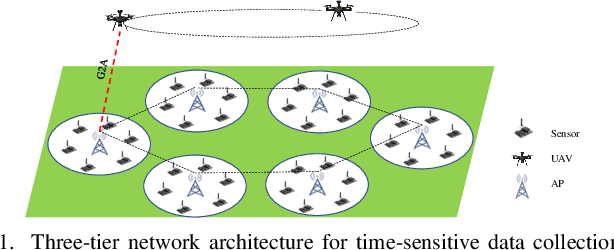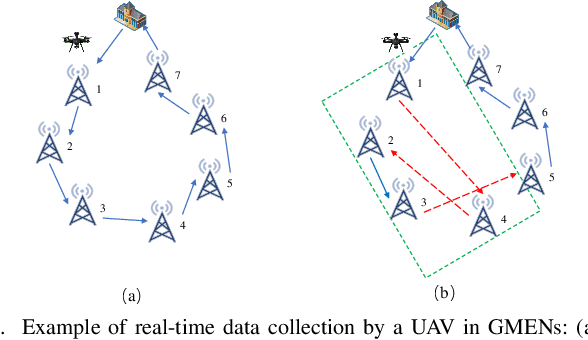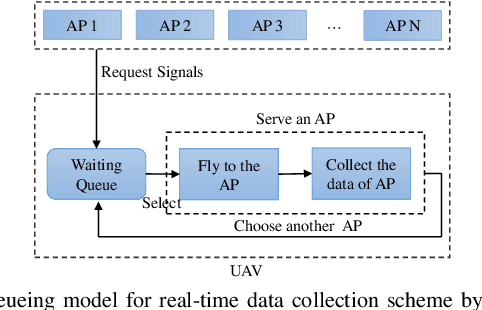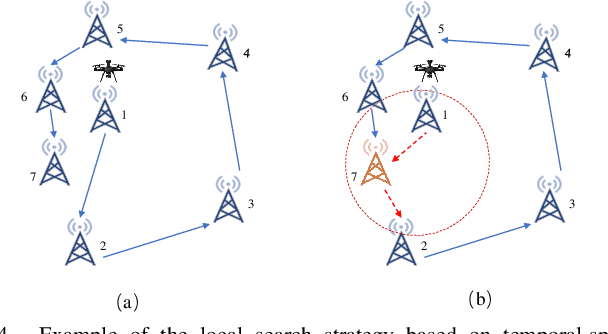Shi Yan
EOTNet: Deep Memory Aided Bayesian Filter for Extended Object Tracking
May 24, 2025Abstract:Extended object tracking methods based on random matrices, founded on Bayesian filters, have been able to achieve efficient recursive processes while jointly estimating the kinematic states and extension of the targets. Existing random matrix approaches typically assume that the evolution of state and extension follows a first-order Markov process, where the current estimate of the target depends solely on the previous moment. However, in real-world scenarios, this assumption fails because the evolution of states and extension is usually non-Markovian. In this paper, we introduce a novel extended object tracking method: a Bayesian recursive neural network assisted by deep memory. Initially, we propose an equivalent model under a non-Markovian assumption and derive the implementation of its Bayesian filtering framework. Thereafter, Gaussian approximation and moment matching are employed to derive the analytical solution for the proposed Bayesian filtering framework. Finally, based on the closed-form solution, we design an end-to-end trainable Bayesian recursive neural network for extended object tracking. Experiment results on simulated and real-world datasets show that the proposed methods outperforms traditional extended object tracking methods and state-of-the-art deep learning approaches.
High-Precision Transformer-Based Visual Servoing for Humanoid Robots in Aligning Tiny Objects
Mar 06, 2025



Abstract:High-precision tiny object alignment remains a common and critical challenge for humanoid robots in real-world. To address this problem, this paper proposes a vision-based framework for precisely estimating and controlling the relative position between a handheld tool and a target object for humanoid robots, e.g., a screwdriver tip and a screw head slot. By fusing images from the head and torso cameras on a robot with its head joint angles, the proposed Transformer-based visual servoing method can correct the handheld tool's positional errors effectively, especially at a close distance. Experiments on M4-M8 screws demonstrate an average convergence error of 0.8-1.3 mm and a success rate of 93\%-100\%. Through comparative analysis, the results validate that this capability of high-precision tiny object alignment is enabled by the Distance Estimation Transformer architecture and the Multi-Perception-Head mechanism proposed in this paper.
Stereo-Talker: Audio-driven 3D Human Synthesis with Prior-Guided Mixture-of-Experts
Oct 31, 2024



Abstract:This paper introduces Stereo-Talker, a novel one-shot audio-driven human video synthesis system that generates 3D talking videos with precise lip synchronization, expressive body gestures, temporally consistent photo-realistic quality, and continuous viewpoint control. The process follows a two-stage approach. In the first stage, the system maps audio input to high-fidelity motion sequences, encompassing upper-body gestures and facial expressions. To enrich motion diversity and authenticity, large language model (LLM) priors are integrated with text-aligned semantic audio features, leveraging LLMs' cross-modal generalization power to enhance motion quality. In the second stage, we improve diffusion-based video generation models by incorporating a prior-guided Mixture-of-Experts (MoE) mechanism: a view-guided MoE focuses on view-specific attributes, while a mask-guided MoE enhances region-based rendering stability. Additionally, a mask prediction module is devised to derive human masks from motion data, enhancing the stability and accuracy of masks and enabling mask guiding during inference. We also introduce a comprehensive human video dataset with 2,203 identities, covering diverse body gestures and detailed annotations, facilitating broad generalization. The code, data, and pre-trained models will be released for research purposes.
Boosting Gaze Object Prediction via Pixel-level Supervision from Vision Foundation Model
Aug 02, 2024Abstract:Gaze object prediction (GOP) aims to predict the category and location of the object that a human is looking at. Previous methods utilized box-level supervision to identify the object that a person is looking at, but struggled with semantic ambiguity, ie, a single box may contain several items since objects are close together. The Vision foundation model (VFM) has improved in object segmentation using box prompts, which can reduce confusion by more precisely locating objects, offering advantages for fine-grained prediction of gaze objects. This paper presents a more challenging gaze object segmentation (GOS) task, which involves inferring the pixel-level mask corresponding to the object captured by human gaze behavior. In particular, we propose that the pixel-level supervision provided by VFM can be integrated into gaze object prediction to mitigate semantic ambiguity. This leads to our gaze object detection and segmentation framework that enables accurate pixel-level predictions. Different from previous methods that require additional head input or ignore head features, we propose to automatically obtain head features from scene features to ensure the model's inference efficiency and flexibility in the real world. Moreover, rather than directly fuse features to predict gaze heatmap as in existing methods, which may overlook spatial location and subtle details of the object, we develop a space-to-object gaze regression method to facilitate human-object gaze interaction. Specifically, it first constructs an initial human-object spatial connection, then refines this connection by interacting with semantically clear features in the segmentation branch, ultimately predicting a gaze heatmap for precise localization. Extensive experiments on GOO-Synth and GOO-Real datasets demonstrate the effectiveness of our method.
A UAV-Enabled Time-Sensitive Data Collection Scheme for Grassland Monitoring Edge Networks
Jul 30, 2024



Abstract:Grassland monitoring is essential for the sustainable development of grassland resources. Traditional Internet of Things (IoT) devices generate critical ecological data, making data loss unacceptable, but the harsh environment complicates data collection. Unmanned Aerial Vehicle (UAV) and mobile edge computing (MEC) offer efficient data collection solutions, enhancing performance on resource-limited mobile devices. In this context, this paper is the first to investigate a UAV-enabled time-sensitive data collection problem (TSDCMP) within grassland monitoring edge networks (GMENs). Unlike many existing data collection scenarios, this problem has three key challenges. First, the total amount of data collected depends significantly on the data collection duration and arrival time of UAV at each access point (AP). Second, the volume of data at different APs varies among regions due to differences in monitoring objects and vegetation coverage. Third, the service requests time and locations from APs are often not adjacent topologically. To address these issues, We formulate the TSDCMP for UAV-enabled GMENs as a mixed-integer programming model in a single trip. This model considers constraints such as the limited energy of UAV, the coupled routing and time scheduling, and the state of APs and UAV arrival time. Subsequently, we propose a novel cooperative heuristic algorithm based on temporal-spatial correlations (CHTSC) that integrates a modified dynamic programming (MDP) into an iterated local search to solve the TSDCMP for UAV-enabled GMENs. This approach fully takes into account the temporal and spatial relationships between consecutive service requests from APs. Systematic simulation studies demonstrate that the mixed-integer programming model effectively represents the TSDCMP within UAV-enabled GMENs.
Explainable Bayesian Recurrent Neural Smoother to Capture Global State Evolutionary Correlations
Jun 17, 2024Abstract:Through integrating the evolutionary correlations across global states in the bidirectional recursion, an explainable Bayesian recurrent neural smoother (EBRNS) is proposed for offline data-assisted fixed-interval state smoothing. At first, the proposed model, containing global states in the evolutionary interval, is transformed into an equivalent model with bidirectional memory. This transformation incorporates crucial global state information with support for bi-directional recursive computation. For the transformed model, the joint state-memory-trend Bayesian filtering and smoothing frameworks are derived by introducing the bidirectional memory iteration mechanism and offline data into Bayesian estimation theory. The derived frameworks are implemented using the Gaussian approximation to ensure analytical properties and computational efficiency. Finally, the neural network modules within EBRNS and its two-stage training scheme are designed. Unlike most existing approaches that artificially combine deep learning and model-based estimation, the bidirectional recursion and internal gated structures of EBRNS are naturally derived from Bayesian estimation theory, explainably integrating prior model knowledge, online measurement, and offline data. Experiments on representative real-world datasets demonstrate that the high smoothing accuracy of EBRNS is accompanied by data efficiency and a lightweight parameter scale.
Performance Analysis of Integrated Sensing and Communication Networks with Blockage Effects
Mar 28, 2024



Abstract:Communication-sensing integration represents an up-and-coming area of research, enabling wireless networks to simultaneously perform communication and sensing tasks. However, in urban cellular networks, the blockage of buildings results in a complex signal propagation environment, affecting the performance analysis of integrated sensing and communication (ISAC) networks. To overcome this obstacle, this paper constructs a comprehensive framework considering building blockage and employs a distance-correlated blockage model to analyze interference from line of sight (LoS), non-line of sight (NLoS), and target reflection cascading (TRC) links. Using stochastic geometric theory, expressions for signal-to-interference-plus-noise ratio (SINR) and coverage probability for communication and sensing in the presence of blockage are derived, allowing for a comprehensive comparison under the same parameters. The research findings indicate that blockage can positively impact coverage, especially in enhancing communication performance. The analysis also suggests that there exists an optimal base station (BS) density when blockage is of the same order of magnitude as the BS density, maximizing communication or sensing coverage probability.
Den-SOFT: Dense Space-Oriented Light Field DataseT for 6-DOF Immersive Experience
Mar 15, 2024



Abstract:We have built a custom mobile multi-camera large-space dense light field capture system, which provides a series of high-quality and sufficiently dense light field images for various scenarios. Our aim is to contribute to the development of popular 3D scene reconstruction algorithms such as IBRnet, NeRF, and 3D Gaussian splitting. More importantly, the collected dataset, which is much denser than existing datasets, may also inspire space-oriented light field reconstruction, which is potentially different from object-centric 3D reconstruction, for immersive VR/AR experiences. We utilized a total of 40 GoPro 10 cameras, capturing images of 5k resolution. The number of photos captured for each scene is no less than 1000, and the average density (view number within a unit sphere) is 134.68. It is also worth noting that our system is capable of efficiently capturing large outdoor scenes. Addressing the current lack of large-space and dense light field datasets, we made efforts to include elements such as sky, reflections, lights and shadows that are of interest to researchers in the field of 3D reconstruction during the data capture process. Finally, we validated the effectiveness of our provided dataset on three popular algorithms and also integrated the reconstructed 3DGS results into the Unity engine, demonstrating the potential of utilizing our datasets to enhance the realism of virtual reality (VR) and create feasible interactive spaces. The dataset is available at our project website.
Multi-level Gated Bayesian Recurrent Neural Network for State Estimation
Oct 26, 2023Abstract:The optimality of Bayesian filtering relies on the completeness of prior models, while deep learning holds a distinct advantage in learning models from offline data. Nevertheless, the current fusion of these two methodologies remains largely ad hoc, lacking a theoretical foundation. This paper presents a novel solution, namely a multi-level gated Bayesian recurrent neural network specifically designed to state estimation under model mismatches. Firstly, we transform the non-Markov state-space model into an equivalent first-order Markov model with memory. It is a generalized transformation that overcomes the limitations of the first-order Markov property and enables recursive filtering. Secondly, by deriving a data-assisted joint state-memory-mismatch Bayesian filtering, we design a Bayesian multi-level gated framework that includes a memory update gate for capturing the temporal regularities in state evolution, a state prediction gate with the evolution mismatch compensation, and a state update gate with the observation mismatch compensation. The Gaussian approximation implementation of the filtering process within the gated framework is derived, taking into account the computational efficiency. Finally, the corresponding internal neural network structures and end-to-end training methods are designed. The Bayesian filtering theory enhances the interpretability of the proposed gated network, enabling the effective integration of offline data and prior models within functionally explicit gated units. In comprehensive experiments, including simulations and real-world datasets, the proposed gated network demonstrates superior estimation performance compared to benchmark filters and state-of-the-art deep learning filtering methods.
LightPainter: Interactive Portrait Relighting with Freehand Scribble
Mar 22, 2023Abstract:Recent portrait relighting methods have achieved realistic results of portrait lighting effects given a desired lighting representation such as an environment map. However, these methods are not intuitive for user interaction and lack precise lighting control. We introduce LightPainter, a scribble-based relighting system that allows users to interactively manipulate portrait lighting effect with ease. This is achieved by two conditional neural networks, a delighting module that recovers geometry and albedo optionally conditioned on skin tone, and a scribble-based module for relighting. To train the relighting module, we propose a novel scribble simulation procedure to mimic real user scribbles, which allows our pipeline to be trained without any human annotations. We demonstrate high-quality and flexible portrait lighting editing capability with both quantitative and qualitative experiments. User study comparisons with commercial lighting editing tools also demonstrate consistent user preference for our method.
 Add to Chrome
Add to Chrome Add to Firefox
Add to Firefox Add to Edge
Add to Edge